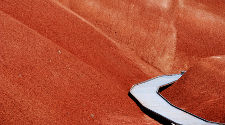
Bentonite buffer erosion as a consequence of intrusion of dilute glacial meltwaters has been identified as a process that could lead to increased corrosion of copper canisters.
The enhanced hydraulic gradients that may exist during periods of glacial retreat can lead to advective fracture flow conditions and where such fractures intersect deposition holes there is the possibility for bentonite to form colloids in the dilute waters and be transported away. This erosion of the bentonite could lead to a lowering of the buffer density, and a reduction in buffer swelling potential and transport resistance, resulting in enhanced transport of corrosive agents to the canister surface than for 'normal evolution' scenarios.
Fully coupled 3-D models of the hydro-mechanical-chemical erosion and corrosion system in the EBS and neighbouring fracture were developed for SSM using Quintessa's general purpose coupled modelling code, QPAC. The models were constructed with the aim of demonstrating the effect of the couplings within the system and accordingly some processes were modelled in a simplified fashion. For example, the model represented the mechanical intrusion of bentonite gel into fractures and redistribution of bentonite within the deposition hole using a nonlinear diffusion equation rather than deploying a fully mechanistic model for each process. This allowed the geometry of regions of altered density that form in the bentonite after sustained periods of erosion to emerge from the model rather than being imposed. Cyclic periods of glaciation were simulated and results demonstrated that cumulative effects of multiple glaciations would be required before the formation of significant regions of low density or cavities is possible, and that the resulting corrosion profiles on the canister surface are uneven corresponding to the geometrically distributed corrodent supply.